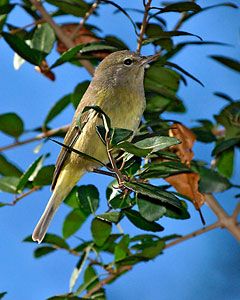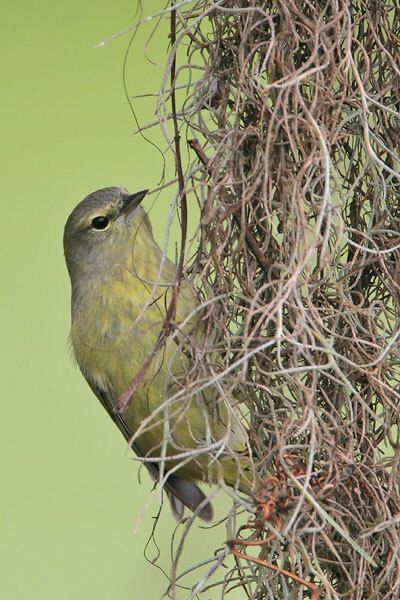Orange-crowned Warbler

© Wayne Nicholas
Leiothlypis celata
Family: (Parulidae) Wood-Warblers
Preferred Habitat: Woodlands and forests.
Seasonal Occurrence: Common October through March. Absent in summer.
Profile by Vicki Stittleburg: The Orange-crowned Warbler causes identification problems for many birders as its drab, olive yellow appearance and lack of field marks make it resemble the females of other warbler species and the namesake orange crown patch is rarely seen. Compared with other warblers, the Orange-crowned has a noticeably thin, sharply pointed bill. It has a thin, faint, dark eye line, a bright yellow eyebrow and a broken eye ring. The undertail coverts are bright yellow and are often the brightest part of the plumage.
The Orange-crowned Warbler is one of our most common warblers in winter and one of the most frequently encountered ones in backyard gardens; however, It is often overlooked as it is well-camouflaged by its gray-green plumage, and it usually forages silently and alone. Look and listen for the Orange-crowned Warbler in dense shrubbery and low trees where they glean insects from leaves. They supplement their insect diet with fruit, berries, seeds, and are common visitors at the sapwells drilled by sapsuckers and some other woodpeckers They often give a high, faint contact call while foraging.
Comments by Don Verser: Orange-crowned Warblers in the east are very late migrants and rare before mid-October. I have only 4 records earlier than 14 October. The very few Orange-crowneds that arrive in late Sep and early Oct are probably western race birds. Identify early Orange-crowned Warblers very carefully. BEWARE that Orange-crowned Warblers can be confused with first fall Tennessee Warblers. Always look at the undertail coverts which are yellow on Orange-crowned and distinctly white on Tennessee. Dull Yellow Warblers might also be confused with Orange-crowned Warblers. Check for the yellow undertail of Yellow Warblers.
Profile by Rachel Myers: The Orange-crowned Warbler is a rather inconspicuous species of warbler common to the upper Texas coast during the winter. They can be seen from October through April and are absent during the summer. Due to their rather drab coloring and silent foraging habits, they can be difficult to spot and distinguish from many warblers, especially females of certain species.
Orange-crowned Warblers are small, with a thin, sharply pointed bill. They are generally olive-yellow overall with a thin, faint eye line and a broken eye ring. Their undertail coverts are always yellow and are a good field mark to keep in mind for identification. Adults have an orangish crown patch, hence the name, but this is usually concealed and difficult to see. Males often raise their crown feathers to flash this patch during territorial displays or when threatened. Males sing a trilling song of sweet, clear notes. Orange-crowned Warbler calls are sharp, high-pitched chip notes, distinctive from other warblers.
Orange-crowned Warblers are often found in shrubs and low-growing vegetation in riparian areas and patches of forest. Overall, they breed in more forest types than nearly any other warbler species. In the winter, Orange-crowned Warblers look for habitats similar to their breeding grounds. These warblers mainly eat invertebrate prey, such as ants, beetles, flies, and caterpillars. In the winter, they will eat fruit, berries, seeds, and will also visit sapwells created by sapsuckers and other woodpeckers. They will also pierce the bases of flowers to eat the nectar.
In late winter and early spring, males will sing as they establish territories to attract a mate, then enter a silent stage as courtship begins. Female Orange-crowned Warblers select the nest site and build the nests, which can take up to four days. After the female has built the nest, the male will start singing again. Nests can be made up out of dead leaves, stems, coarse grass, fine twigs, bark and moss. The average clutch size for these warblers can range from 3 to 6 eggs.
Many Orange-crowned Warblers winter in Mexico, with some continuing south to Guatemala and Belize. Others will winter in central California and the southeastern United States. After winter, they migrate north to breed in the northwestern United States, Canada, and Alaska. Some can be seen year-round in the western United States, depending on where you are. Orange-crowned Warblers can be seen at many of the Houston Audubon sanctuaries early spring, including Smith Oaks, Boy Scout Woods, Edith L. Moore, Eubanks Woods, and S.E. Gast Red Bay.
-
Cornell Lab of Ornithology
-
Bird Guide

© Greg Lavaty, www.texastargetbirds.com

© Greg Lavaty, www.texastargetbirds.com

© Greg Lavaty, www.texastargetbirds.com

© Greg Lavaty, www.texastargetbirds.com




















